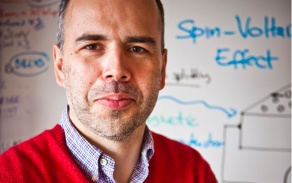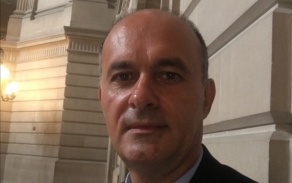
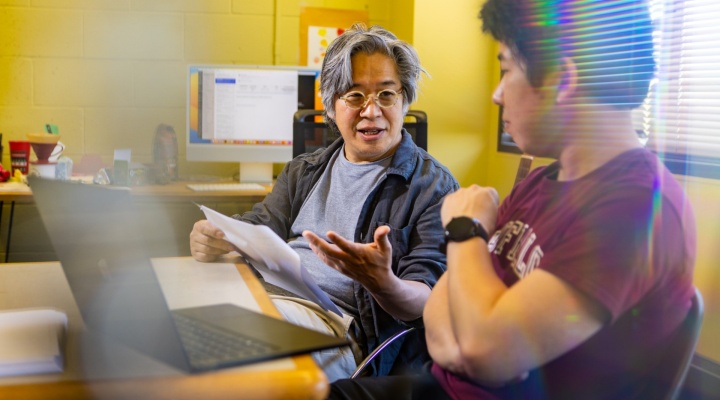
Professor Jong Han is the lead author of a new study that helps solve a longstanding physics mystery on how insulators transition into metals via an electric field, a process known as resistive switching. Read more about Han's research that solves the mystery of insulator-to-metal transition. Photo: Douglas Levere
In this Issue:
Support your Department
Dear Alumni and Friends of UB Physics,
Time flies! Another year is passing, and we have a lot of great news to share with you on the achievements of our students, faculty, and alumni. To start off, Paul Dewan Jr., a former undergraduate student in the Department and mentored by Professor Priya Banerjee, has won the prestigious and extremely competitive NSF Graduate Research Fellowship (NSFGRF). He is now a graduate student in Harvard studying biophysics. In the meantime, Professor Igor Žutić has become our latest SUNY Distinguished Professor for his various research achievements in spintronics and topological quantum computing, in addition to his successful mentoring of our undergraduate and graduate students as well as postdocs, many of whom were Goldwater and NSFGRF winners or were placed in faculty positions around the world.

One piece of news that has been very important to the Department is that UB was named a SUNY Flagship Campus in 2022 in recognition of UB’s excellence in research and education and its utmost importance to the Western New York area. With this recognition came significant and timely investment from the State of New York. Led by the then-chair Professor Murthy Ganapathy, we grasped this opportunity and gained approval to make at least four tenure-track hirings in the general research area of quantum science and technology over the next two years. In the spring of 2024, two new members will join the faculty: Associate Professor Wanyi Nie, who works on novel quantum materials, and Assistant Professor Dusan Sarenac, whose research specialty is in neutron scattering and quantum optics. These (and coming) additions, together with the hiring of Professors Changjiang Liu and Herbert Fotso from last year, represent a remarkable growth spurt for the Department and position us well for the coming decades in broadening research and education opportunities for our students and faculty alike. The influx of new faculty members and new research specialties will also help ensure the long-term health of the Department.
Several current Physics faculty members have received external recognition and awards for their achievements at UB and beyond. In addition to Professor Žutić’s promotion to the Distinguished Professor rank, Professor Hao Zeng has received the SUNY Chancellor’s Award for Excellence in Scholarship and Creative Activities for his contributions to research on novel materials; Professor Dejan Stojkovic received the UB Exceptional Scholar Award for Sustained Excellence in Research for his works on fundamental problems at the interface of particle physics, gravity, and cosmology; Professor Grady Gambrel has been selected as an EDJI (Equity, Diversity, Justice and Inclusion) Faculty Fellow by the UB Office on Curriculum, Assessment, and Teaching Transformation to explore how to incorporate the ideals of EDJI into physics teaching; and last but not least, Professor Priya Banerjee received an NSF CAREER Award for his impactful research on biomolecular condensates. In addition, Professor Banerjee has also become an Associate Editor of the journal Biophysics Reviews, published by the American Institute of Physics, while Professor Surajit Sen is appointed as a member of the Advisory Editorial Board of Physica A, the premier journal in the world for statistical mechanics.
Our undergraduate students have their intense study schedule in school as usual but also have had some interesting extracurricular activities this year. For example, Krish Patel, Dario Tringali, and Zaw Oo Ko, three senior physics students, have participated in the 2023 Intercollegiate Rocket Engineering Competition as part of a UB team. In particular, Patel is the team’s project director and leads flight simulation and recovery system sections, while Tringali (who also served as president) and Zaw lead the avionics section, in charge of designing custom electronics for data tracking and rocket telemetry. The UB team competed successfully, with their rocket, nicknamed VROOM, reaching an altitude of 9000 ft, and being successfully recovered with no damage. The three will give a departmental colloquium to discuss their exciting experience in the competition.
In the Fall of 2023, we have 18 new graduate students joining UB Physics. This is one of the largest incoming classes in recent years and injects fresh excitement into our graduate program. Together with new hires in the faculty rank, we look forward to continued growth in both the size of our graduate program and the research productivity of the department.
In March of 2023, we had our first UB Physics Reunion at the APS March meeting since the Covid-19 pandemic. About 30 current faculty members and students and several alumni and friends attended, including Professors Sergio Ulloa (former student of Y.C. Lee) and Nancy Sandler from Ohio University, Dr. Satoshi Okamoto from Oak Ridge National Lab, and Professor Myoung-Hwan Kim (former student of John Cerne) from Texas Tech.
In April 2023, our Moti Lal Rustgi Lecture was given by Professor Michael Peshkin of SLAC and Stanford University, with the title “Higgs Boson: the ‘god particle’ takes a human face.” Our Wu Lecture in the fall of 2023 has been delayed to 2024 due to medical reasons, but we can now look forward to some exciting speakers in 2024.
As mentioned above, there is a change in the Department leadership. Professor Sambandamurthy Ganapathy, our chair for the past four years, has become the Associate Dean for Research at the College of Arts and Sciences because of the great leadership qualities he has demonstrated as the Physics Chair. For the fall of 2023, I have been appointed as the Interim Chair of the Department, and a new chair will be appointed before the end of 2023. Furthermore, Professor Priya Banerjee has taken over the post of the Director of Graduate Studies.
With great sadness, we report the passing of Professor Yung Chang (Y.C.) Lee earlier this year and Professor Shigeji Fujita recently. Professor Fujita and Lee joined UB Physics in 1966 and 1967, respectively. Both are condensed matter theorists and have a great passion for physics in both research and teaching. Both left indelible marks of their own on many students at UB Physics and will be missed.
I would like to end this message with a sense of optimism and anticipation. With the pandemic mostly in our rearview mirror, the department is seeing renewed growth in faculty, students, teaching and research activities, and most importantly, in excitement for what we can achieve in the future.
Please stay in touch with us, and share with us stories of your work and your life. Stay safe, and stay healthy!
Best wishes,
Xuedong Hu
Chair and Professor of Physics
In Memoriam
With great sadness, we report the passing of Professor Yung Chang (Y.C.) Lee and Professor Shigeji Fujita.
Professor Lee joined UB Physics in 1967. His great passion for physics and his unwavering commitment to excellence in teaching and research, including his penetrating questions in all the colloquiums and seminars he attended, have left indelible marks in the Department and among the many students whose lives he touched. As one of the last gifts to the Department, he established the endowment for the Ta-You Wu Lecture before his retirement, which has given us many prominent speakers from various research fields since its inception.
With heavy heart, we report the passing of Professor Shigeji Fujita on October 10, 2023, at the age of 94. Professor Fujita joined UB Physics in 1966. As a condensed matter theorist, he did research in multiple areas within solid-state physics, including making important contributions to the study of the quantum Hall effect. He wrote and edited many books as well. His students all recall him as a gentle, generous soul, always encouraging and always helping.
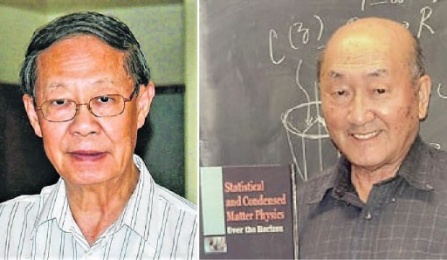
Yung Chang (Y.C) Lee (left) and Shigeji Fujita (right)
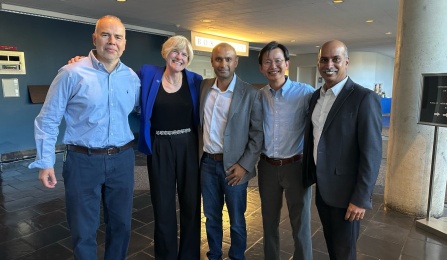
(From left to right) Igor Žutić, Dean Robin Schulze, Priya Banerjee, Xuedong Hu and Murthy Ganapahty at the Advancing Excellence celebration.
Advancing Excellence
By Xuedong Hu, PhD
On September 20, the College of Arts and Sciences held the first-ever Advancing Excellence event in Slee Hall, where Dean Robin Schulze recognized a wide range of scholarly achievements by faculty members from the College. Several Physics faculty members were prominently featured in her slideshow, including Igor Žutić for becoming a SUNY Distinguished Professor, Hao Zeng for receiving the SUNY Chancellor’s Award for Excellence in Scholarship and Creative Activities, and Priya Banerjee for receiving an NSF CAREER Award. Herbert Fotso, Ia Iashvili, and Salvatore Rappoccio are also presented either in her speech or in a College-produced video.
Research News
How RNA Phase Separates
By Priya Banerjee, PhD
Reversible phase separation of condensates comprised of proteins and ribonucleic acids (RNA) regulates a variety of evolutionarily conserved biochemical processes in living systems. The so-called molecular grammar, i.e., the primary sequence of the chain encoding phase separation of proteins, has been explored. However, the formation of many biomolecular condensates containing ribonucleoprotein (RNP) complexes critically depends on RNA. A recent study of neurodegenerative CG-rich repeat expansion disorders suggested that RNA phase separation was essential to the disease process. This and other observations beg a deeper understanding of the process of RNA-dependent phase transitions of RNP granules.
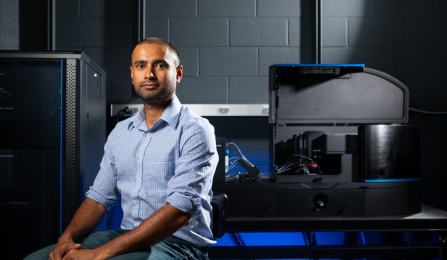
Priya Banerjee is the co-author of a recent Nature Chemistry paper titled “RNAs undergo phase transitions with lower critical solution temperatures.” Photo: Douglas Levere
Intuition leads to the expectation that RNA-based condensates are formed through nucleobase-specific interactions. This model predicts a dominant role of enthalpy driving the RNA phase transition, which must be suppressed at high temperatures. To our surprise, we discovered that RNA phase separation is driven by entropy. Using experiments and simulation, we showed that RNAs undergo phase separation upon heating with lower critical solution temperatures (LCSTs). Importantly, the LCSTs are RNA sequence and structure-dependent. RNA droplets were notably liquid-like at high temperatures but formed an irreversible system-spanning network at temperatures below their LCSTs, which we called a percolation transition. Percolation led to hysteresis, where these RNA condensates persisted at temperatures below their LCSTs. Overall, our discovery that RNAs have a universal tendency to undergo phase separation with LCSTs expands the mechanistic understanding of this rare type of phase transition in living systems and highlights the need to incorporate RNA-driven phase transitions into models for stress-inducible RNP granule biogenesis.
Department Events

The Department of Physics hosted the 127th Topical Symposium of the New York State Section of the American Physical Society at UB Under the theme of "Quantum Science and Technologies."
127th NYSSAPS Symposium Explores Quantum Science and Technology
By Changjiang Liu, PhD, Hao Zeng , PhD, and Herbert Fotso, PhD
The Department of Physics hosted the 127th Topical Symposium of the New York State Section of the American Physical Society (NYSSAPS) on April 28, 2023. Under the theme of "Quantum Science and Technologies," this event brought together experts and enthusiasts from across New York State and neighboring regions to explore the fascinating world of quantum science.
The event commenced with opening remarks delivered by Venu Govindaraju, Vice President for Research and Economic Development (VPRED), Robin Schulze, Dean of the College of Arts and Sciences (CAS), and Sambandamurthy Ganapathy, Chair of the Department of Physics. Venu underscored UB's steadfast commitment and investment in the field of quantum science and technology, Robin highlighted CAS's support through faculty recruitment, and Murthy emphasized the remarkable growth of the physics department, which anticipates filling eight positions by the fall of 2024.
The symposium featured presentations from renowned researchers, including Kin Fai Mak from Cornell University, Nitin Samarth from Penn State University, Andrew Kent from New York University, Dominik Schneble from Stony Brook University, Andrea Alù from City University of New York, Samindranath Mitra from the Physical Review Letters, Mingzhao Liu from Brookhaven National Laboratory, Kathy-Anne Soderberg from the Air Force Research Laboratory, and John Nichol from University of Rochester. Their talks spanned a wide range of topics, encompassing 2D materials, spintronics, quantum metamaterials, quantum simulations, superconductor qubits, and quantum networks. A highlight of the day was the engaging discussion on the innovation cycle for quantum technologies, given by David Cory from the University of Waterloo.
Approximately 100 participants, primarily comprising graduate and undergraduate students, attended the symposium. A poster session was held, with over 40 posters presented by students and postdocs, providing them with the opportunity to network and interact with leading researchers and fellow students. A poster prize ceremony was held during the conference banquet.
The Symposium was co-organized by Herbert Fotso and Changjiang Liu, two new hires of the Department of Physics in the field of quantum physics, jointly with Hao Zeng, the Moti Lul Rustgi Professor of Physics and Vasili Perebeinos, Professor of Electrical Engineering. Generous support was provided by the VPRED office, the School of Engineering and Applied Sciences, CAS, the Department of Physics, the Department of Electrical Engineering and the American Physical Society. The dedicated efforts of the physics staff and student volunteers helped make this event a great success.
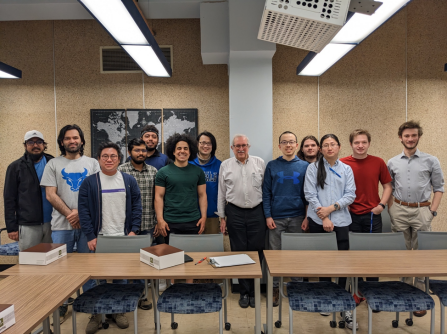
Professor Michael Peskin (center), who gave the 2023 Moti Lal Rustgi Memorial Lecture, is at a lunch meeting with undergraduate and graduate students.
2023 Moti Lal Rustgi Memorial Lecture
By Doreen Wackeroth, PhD
On April 21, 2023, the physics department hosted the 27th Moti Lal Rustgi Memorial Lecture. The Moti Lal Rustgi Memorial Lecture Series was established in 1993 through a generous endowment from the Rustgi family to honor and remember former physics colleague Professor Moti Lal Rustgi. The lecture is given annually by distinguished researchers in a broad area of physics study. The 27th lecture in this series, titled "Higgs Boson: The God particle takes a Human Face," was delivered by Michael E. Peskin, Professor of Particle Physics and Astrophysics at SLAC and Stanford University. Professor Peskin is a world-renowned theoretical particle physicist with a broad range of research interests, who also published a leading textbook in this field, “An Introduction to Quantum Field Theory”. The lecture introduced the audience to the Higgs boson, a particle which has been discovered in 2012 in the high-energy collision of protons at the CERN Large Hadron Collider near Geneva, Switzerland. Professor Peskin explained what we have learned about this new particle since its discovery and “the mysteries about the Higgs boson we still struggle to solve.”

From left to right: Luke DiFato, Joseph Ferrantini, and Zaw Oo Ko, along with friends and faculty who celebrated their induction. Photo by Andrea Markelz.
Sigma Pi Sigma honor society induction ceremony
By John Cerne, PhD
On December 9, 2022, Luke DiFato, Joseph Ferrantini, and Zaw Oo Ko were inducted into the Sigma Pi Sigma Physics Honor Society. This honor goes to our top majors, who were joined by physics faculty and friends to celebrate their induction at UB.
UB QuarkNet Outreach Center
By Ia Iashvili, PhD and Avto Kharchilava, PhD
QuarkNet is a nationwide, long-term teacher professional development program sponsored by the National Science Foundation. It provides an opportunity for high school physics teachers and students to come in close contact with fundamental research in High Energy Physics. The UB High Energy Physics group has operated the QuarkNet center since 2006, with Dr. A. Kharchilava and Dr. I. Iashvili serving as mentors of the center. The UB QuarkNet organizes hands-on research workshops for local high school teachers every summer. Since 2013, the center has given annual MasterClasses for high school students to analyze data recorded by the Compact Muon Solenoid experiment at the Large Hadron Collider (CERN, Geneva, Switzerland). Over the years, about 20 local high school science teachers have benefitted from the UB QuarkNet program. Two of our participating teachers, Mr. D. McClary and Mrs. J. Gazdovich, have been selected for the competitive International High School Teacher Program and spent the summer at CERN. Another teacher, Mr. L. Hiller, was invited to a teachers’ conference in Marathon, Greece, and several others participated in a coding camp at Fermi National Accelerator Laboratory (Batavia, IL). With the support of QuarkNet, several local high schools operate Cosmic Ray Detector to record and analyze cosmic muon data for classroom demonstrations and student capstone projects.

UB QuarkNet mentors Professor Iashvili (3rd from left) and Professor
Kharchilava (right), explain High Energy Physics principles to UB QuarkNet 2023 Workshop participants: (from left to right) Dr. O. Buria (West Seneca Christian School, Academic Dean), Mr. L. Hiller (Nichols High school science teacher), Ms. A. Zhu (Nichols High School student), and Mr. Ph. Coburn Hiller (Nichols High School science teacher).
2022 Holiday Party and 2023 Welcome BBQ
By Nicole Pannullo
The Department of Physics celebrated the holiday season on December 10, 2022, with our Annual Holiday Party and Award Ceremony open to all employees, students, and their families in the UB Student Union. Tracy Gasinski and Rachel Bolden organized the event with help from student and faculty volunteers. The annual holiday party and awards presentation provide dedicated time for our Physics community to come together with family to share a meal, celebrate the accomplishments of our undergraduate and graduate students, and enjoy live entertainment. We also hosted our Annual Welcome BBQ for incoming, new graduate students and their families on August 25, 2023, to introduce new students to the entire department. The event was organized by Rachel Bolden and Nicole Pannullo which included a BBQ and awards presentation to recent scholarship winners. Our thanks to Scott Whitmire and Morgan Santora for serving as our BBQ Masters. These events provide a sense of community and celebration for the department.
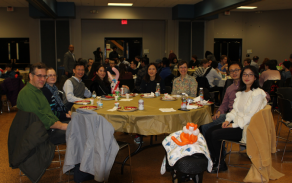

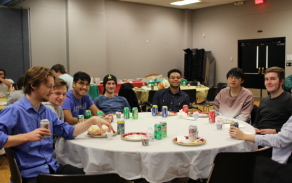
Physics Open House 2023
By John Cerne, PhD
The Department showcased its academic and research opportunities to prospective undergraduate students on Saturday, October 21, 2023. The day began with a physics information table at the Center for the Arts, where our CAS Ambassadors Krish Patel, Zaw Oo Ko, and Dr. Cerne talked with prospective students and their families. After that, Dr. Hu gave a welcome talk, where he emphasized the outstanding achievements of our undergraduate students. He also was able to report on the exciting growth of our department and new research opportunities with two new faculty hires last year and three new faculty searches starting this year! Dr. Hu’s talk was followed by tours of the Zeng, Markelz and Ganapathy labs. PhD student Lauren Samson showed the quantum dots that she fabricated and the facilities she used to make them. Dr. Markelz talked about probing protein dynamics using THz radiation, and PhD student Nicholas Jerla explained his magneto-transport research using a cryogen-free magneto-optical cryostat. Nicholas got his BS in Physics from UB, so he was able to talk about his research experiences as an undergraduate at UB and the important role undergraduates play in research in the department. The lab presentations were excellent, and the speakers were able to motivate their cutting-edge research while making it more accessible to our visitors. We finished the day with a tour of the Foucault pendulum given by Dr. Cerne.
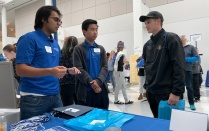
Krish Patel (left) and Zaw Oo Ko (middle) are talking to a prospective undergraduate student at Open House. Photo: J. Cerne
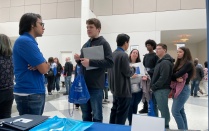
Krish and Zaw are talking with prospective undergraduates and their families. Photo: J. Cerne
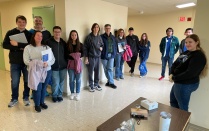
Prospective undergraduate students and their families at Lauren Samson’s (right) presentation. Photo: J. Cerne

Nicholas Jerla (left) is talking about his magneto-transport research. Photo: J. Cerne
Surajit Sen
Surajit Sen, professor of physics, whose current research is focused on a range of complex dynamical systems, was on sabbatical leave in Spring 2023. He served as a Distinguished Visiting Professor of Biosciences and Bioengineering at the Indian Institute of Technology Jodhpur in the period between January and August 2023. During his stay, Surajit engaged in starting two major new research efforts at Jodhpur and in continuing with his current projects on the dynamics of electoral processes and the nucleation of extremists in social systems, the study of massive rogue fluctuations in strongly nonlinear, non-integrable many-body systems, and on acoustic transmission in granular metamaterials. The work at Jodhpur is highly collaborative in nature and involves teams of engineers, bioscientists, humanities and social sciences, and business school faculty. The two projects with IIT Jodhpur are (i) on developing a broad understanding of the food webs and their stabilities in the Thar desert ecosystem and (ii) on developing the concept of sustainable microcities as a unit for re-designing extant functioning urban environments into highly sustainable complex systems (this work is aligned to the Future Cities project of the Office of the Prime Minister, Republic of India).
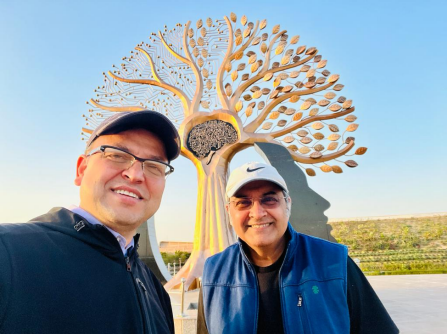
Surajit Sen (right), Distinguished Visiting Professor of Biosciences and Bioengineering at the Indian Institute of Technology (IIT) Jodhpur, with Mohan Dangi (left) from Cal State, Fresno, visiting as a Fulbrighter from Tribhuvan University in Nepal, at IIT Jodhpur campus.
During this sabbatical period, Surajit collaborated with Dr. Mara Huber, Director of UB’s Experiential Learning Network, Prof. Gene Morse at UB, and several others to develop and introduce a pilot study program that involves undergraduate students from all 64 SUNY campuses in examining the highly complex process of rural development in Asia, Central America, and Africa. This work has been awarded a New York State IITG grant of $57,000 in early 2023 for a one-year period. Dr. Huber is leading the program from UB’s ELN Office for all SUNY students.
Surajit Sen was appointed to the Advisory Editorial Board of Physica A (Elsevier) in July 2023. Physica A has historically been one of the leading journals in statistical physics. It has a 2023 impact factor of 3.3, a cite score of 7.5, and a 25% acceptance rate.
In addition to initiating new collaborative research, his creative outputs comprise the following:
- Developed the online College Physics course, which is openly available. The course has been co-developed by Dr. Rahul Kashyap, Mr. Cody Kowal, and several members of the CMU-OLI team. The development of the course at SUNY Buffalo was funded by a NY State Grant.
- Invited talk “Frequency and amplitude attenuation using decorated granular metamaterials,” Study of solitary waves in non-integrable systems, 2nd UAEU Nonlinear Physics Group Symposium: Recent Trends in Soliton Theory and Application, United Arab Emirates, February 22, 2023. (online).
- “Can a typical urban population survive an airborne pandemic?” Seminar at the School of Liberal Arts (SOLA), Indian Institute of Technology, Jodhpur, India, March 31, 2023.
- “About sand, nonlinear dynamics, and metamaterials,” Mechanical Engineering Seminar, Indian Institute of Technology, Jodhpur, India, February 27, 2023.
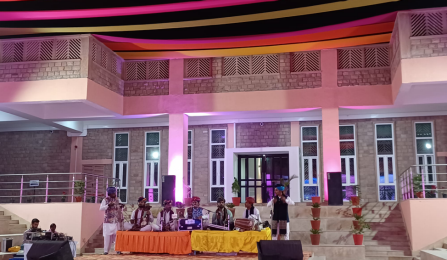
Traditional Rajasthani music session at IIT Jodhpur campus.
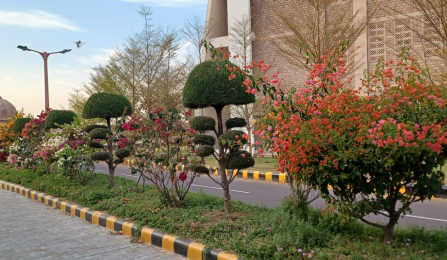
The trees near the administrative building at IIT Jodhpur, India.
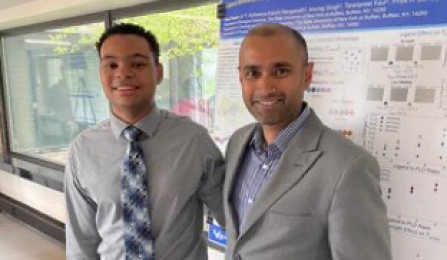
Associate Editor of Biophysics Reviews
In Fall 2023, Pria Banerjee (right) was appointed as an Associate Editor (AE) of "Biophysics Reviews" (BPR), AIP Publishing. The Editor-in-Chief of BPR, Prof. Kit Parker, Harvard University, recognized Banerjee’s seminal contributions to the field of Biophysics and invited him to join the editorial board. BPR was launched in 2020 and modeled after Applied Physics Review (IF: 15). This journal is primarily focused on publishing authoritative reviews on a wide range of biophysics topics such as biomechanics, bioimaging, soft robotics, and computational biology. As an Associate Editor, Banerjee’s job will be to contribute to the journal’s scientific development, visibility, and growth.
Forever 1928
Tom Gruenauer has built some of the world’s most advanced scientific instruments at the UB Instrumentation Shop for over thirty years, but he also has been restoring wooden power boats since 1983. His latest boat restoration project took thirty-four years. He started working on the 24-foot Chris Craft triple cockpit runabout the same year that he joined the College of Arts and Sciences Machine Shop in 1989. The boat was originally built in 1928, and Tom had to replace 80% of the wood and find a historically correct vintage engine along with most of the boat’s hardware. Since he removed/replaced one plank of wood at a time, the boat is still considered by the US Coast Guard to be the original 1928 version rather than a new build. He was restricted to glues and hardware that were used on these boats in 1928, so no modern epoxies or even Phillips head screws, which were invented in the early 1930s!

Left to right: John Cerne, Tom, “Forever 1928,” and Andrea Markelz at the Grand Island boat show. Photo: John Cerne
Tom had to document and photograph every part of the restoration. One of the biggest challenges was that almost all the hardware on the boat had to be replaced, which involved lots of searching for antique parts or rebuilding by hand. Tom found a bare engine block and had to completely rebuild it, which was hampered by some bad advice that he received from a so-called expert. All the outer hull planks had to be replaced, and since many of these pieces are curved, Tom had to steam the wood to bend it to the correct shape. I am impressed by the patience and dedication that Tom put into the restoration, so I asked him what kept him going throughout this very demanding work. He said that was the easy part and that he really enjoyed the process. The first boat he bought was completely finished, so he got bored with it and sold it. He admitted that applying the final finish was challenging and at times, frustrating. He hand-applied 15 coats of varnish (again, no sprayed-on polyurethane finish allowed!), which required hand sanding after each coat.
The boat was named “Forever 1928” since Tom’s daughter told him that it was taking forever to finish it. “Forever 1928” was finally put into the water in July 2023. It has already won numerous awards this summer, which are listed below:
- 40th Annual Wine Country Classis Boat Show in Hammondsport, NY: People’s Choice Award, Dockmaster’s Choice Award, and Best in Show Award.
- 59th Annual Antique Boat Show in Clayton, NY (around 100 boats competed!): Craftsmanship Award and Best Antique Restored Runabout.
- 44th Annual Niagara Frontier Antique and Classic Boat Show on Grand Island, NY: Best of Show Restored Boat Award and the Craftsmanship Award
Boats are judged on a scale of 100 possible points, and Tom had two 99s and a 96.5! Several UB colleagues and I were able to see “Forever 1928” at a boat show on Grand Island. I am an avid woodworker but have never seen so much beautifully finished mahogany in my life! For example, Tom cut the screw-covering plugs from the same wood that was used in the hull planking and then aligned the grain of each plug to match the planks perfectly. The plugs on the boat next to Tom’s, the same model produced in the same year, were clearly visible, but I could not find a single plug (and there are hundreds of them) on Tom’s boat! When he worked at UB, that kind of attention to detail and mechanical ability made Tom a great resource for experimentalists in the Physics Department. The photos that are included in this article do a much better job of showing off Tom’s craftsmanship better than any text I can write, but even those photos do not do justice to the wonderful work that Tom invested into that boat; you must see it firsthand to really appreciate it.
I started working at UB over 20 years ago and enjoyed getting regular updates on Tom’s progress on the boat. I was very impressed by his patience and long-term dedication to getting the boat restored. I am so glad that the work has culminated so successfully, and I look forward to seeing Tom’s next project, which is another Chris Craft boat that Tom has already started working on.
Faculty Awards

Dr. Bruce McCombe, SUNY Distinguished Professor Emeritus, was named among the 153 Outstanding Referees 2023 of the Physical Review journals, as the journal editors chose. The Outstanding Referee program expresses appreciation for the essential work of anonymous peer reviewers. Each year, a small percentage of our 82,000 active referees are selected and honored with the Outstanding Referee designation. Selections are made based on the number, quality, and timeliness of referee reports as collected in a database over the last 40 years.

Professor Hao Zeng has been awarded a three-year NSF DMR grant titled "Investigating Magnetism, Spin Texture, and Magnetotransport Phenomena in 2D Materials." In this project, his group will focus on the synthesis of novel self-intercalated covalent 2D magnets and 2D magnet/van der Waals semiconductor heterostructures. Their primary goal is to investigate, manipulate, and optimize emergent spin-based topological and magnetotransport phenomena within these materials. The anticipated outcomes of this project are poised to impact modern electronics, sensing technologies, and quantum information processing.
Hao Zeng is also a co-PI of a $3M DOE grant titled “High Performing, Durable, Low-PGM Catalysts and Membrane Electrode Assemblies for Medium- and Heavy-Duty Applications”. The project will focus on creating efficient, cheap, durable catalysts for hydrogen-powered fuel cell trucks. Zeng’s group will be responsible for studying CoPt and FePt based nanoparticle catalysts for oxygen reduction reaction.
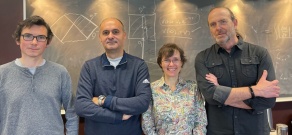
Professors Ciaran Williams, Dejan Stojkovic, Doreen Wackeroth and Will Kinney received a grant from the National Science Foundation to conduct a wide-ranging research program that aims to provide answers to key open questions at the frontier of particle physics, cosmology, and gravity research. Research topics to be investigated span a large range, including the physics of cosmological inflation, the physics of black holes, the physics of Dark Energy (which is believed responsible for driving accelerated cosmological expansion), the properties of the Higgs boson, and studies of the theory that underlies the strong and electroweak interaction and their effects at the CERN Large Hadron Collider and at future accelerators.

Professor Grady Gambrel was nominated as an EDJI Faculty Fellow for the 2023-2024 academic year. The EDJI (Equity, Diversity, Justice, and Inclusion) Faculty Fellows Program was developed by UB’s Office of Curriculum, Assessment and Teaching Transformation (CATT) to improve the inclusivity of UB’s curriculum and instruction. Throughout the year, Dr. Gambrel will be trained to help other professors within the department teach more inclusively and develop a welcoming environment for students of all backgrounds. As a College of Arts and Sciences representative, he will also connect with committees supporting equity, diversity and inclusion within other departments.
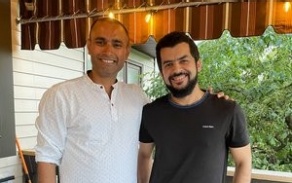
Priya R. Banerjee (left) with his PhD student Ibraheem Alshareedah (now a postdoctoral researcher at Harvard University).
Associate professor Priya R. Banerjee, PhD, is an experimental biophysicist whose research group employs innovative microscopy and single-molecule spectroscopy tools to understand the physical principles, properties, and functions of biomolecules. He is an expert on intrinsically disordered proteins (IDPs), an intriguing class of proteins that lack a rigid structure but play decisive roles in cellular physiology and pathology. In 2023, he received a prestigious National Science Foundation CAREER Award for his project, “Dissecting Phase Behavior of Pioneer Transcription Factor Condensates and Their Role in Gene Regulation.” This project focuses on special proteins called transcription factors (TFs) and a subset called pioneer transcription factors (PTFs). “Transcription factors are proteins that begin the process by which information flows from our DNA to RNA to proteins,” he said. As a biophysicist, his interest is in the mechanisms by which the TFs switch on a particular gene. Given that our genomic DNA is severely compacted—a six-foot strand carrying about 30,000 genes is contained in each cell—most of the time, a particular gene cannot be physically accessed for transcription. Through this award, Banerjee will test an emerging idea of how TFs control when and how genes in our DNA are expressed through liquid-liquid and liquid-solid phase transitions. In parallel, he plans to work with SayYesBuffalo to provide mentorship and research opportunities in his lab to underrepresented minority students and Buffalo Public School teachers. Banerjee is also interested in communicating science to the general public, and he plans to work with the Coalesce Center for Biological Art at UB to promote biophysics education through local and global art exhibitions.
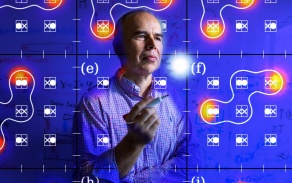
Professor Igor Žutić, received a Multidisciplinary University Research Initiative (MURI) grant titled “Epitaxial Phase-Biased Josephson Junctions,” from the U.S. Office of Naval Research, which built on a previous collaboration with the experimental group of Professor Javad Shabani at the New York University. This team effort, led by Professor Shabani and also involving researchers from Yale University, the University of Maryland, the University of Pittsburgh, and the University of Illinois, Urbana-Champaign, will provide a platform for manipulating elusive Majorana bound states, a key element for the fault-tolerant quantum computing. This topic is also an opportunity to broaden related research in our Department, which also involves Professor Jong Han and Associate Professor Herbert Fotso.
Professor Žutić also received a grant titled “Quantum Materials: Magnetism, Spin-Orbit Coupling, and Superconductivity, from the U.S. Department of Energy, Office of Science, Basic Energy Sciences, which is a renewal of his prior funding, started in 2010. Advances in quantum materials and their heterostructures provide fascinating opportunities to reveal novel phenomena and test previously unexplored states of matter. The reduced dimensionality of the building blocks of such heterostructures and the improved interfacial quality enable the targeted use of proximity effects in materials design. A given material can be transformed through proximity effects whereby it acquires properties of its neighbors, for example, becoming superconducting, magnetic, topologically nontrivial, or with an enhanced spin-orbit coupling.
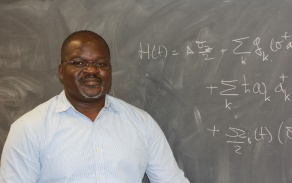
Professor Herbert Fotso received a collaborative research grant from the Department of Energy (DOE) for his project on: “Nonequilibrium Dynamics of Non-Ideal Quantum Materials”. The goal of this project, in collaboration with co-PI Prof. Hanna Terletska of Middle Tennessee State University, is to develop novel solutions for the characterization and understanding of the nonequilibrium dynamics of many-particle systems that feature a non-trivial interplay between strong interaction and disorder. While inhomogeneities are unavoidable in all realistic materials, their precise roles in numerous properties of correlated systems remain generally unclear. This project aims to fill the void that exists, in particular, in the understanding of what role disorder plays in the nontrivial dynamics of strongly correlated systems away from equilibrium.
Professor Fotso also received a second collaborative National Science Foundation (NSF) research grant with Prof. Hanna Terletska of Middle Tennessee State University on: "Quantum@MTSU: Building QISE Research and Education in Middle Tennessee." This award is part of the ExpandQISE effort at NSF. The project aims to help establish a strong QISE (Quantum Information Science and Engineering) effort in the Middle Tennessee area. The research will focus on developing control protocols for quantum emitters in dynamic environments for optimal light-matter interfaces in quantum information processing. In addition, the project will include a strong education and outreach component.

Profs. Xuedong Hu and Peihong Zhang have recently been awarded, as part of a large collaborative team, a research grant from the Air Force Office of Scientific Research (AFOSR) for studying the correlation between materials properties and the performance of spin qubits in silicon quantum dots. This is a large collaborative project (total budget over $6,000,000; UB budget: $1,020,000) involving research groups from the University of Rochester, UCLA, Stony Brook, SUNY Polytechnic Institute, Lawrence Livermore National Laboratory, and UB. Silicon spin qubits are an excellent platform for quantum computing, although several material challenges present obstacles to their continued development. In this project, in collaboration with both theoretical and experimental research groups, we will take a materials-first approach to discover the underlying causes of these challenges and establish correlations among qubit metrics, materials properties, and measurements reflecting these challenges.
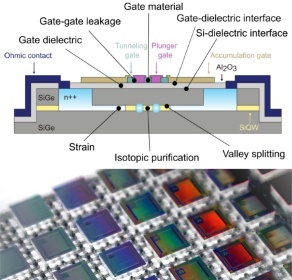
Top: A typical spin qubit device in Si. The qubits (represented by the two blue dots) exist in a complex environment that contains nearby metal gates and amorphous oxides. Our goals are to identify components of this environment that negatively affect qubit coherence and control properties and how to mitigate their influences. Bottom: Schematic of a silicon-based quantum chip.
Faculty recognition by the University
By Xuedong Hu, PhD
Multiple Physics faculty members received external awards in recognition of their excellence in research.
Professor Igor Žutić
Igor Žutić has become the latest SUNY Distinguished Professor from the Physics. Žutić is a globally renowned condensed matter theoretical physicist who is recognized for his seminal discoveries related to spin-dependent transport and superconducting junctions. Žutić’s predictions for spin-photodiodes, spin-transistors, and ultrafast spin-lasers, have been experimentally realized, complementing commercial spintronic applications, while his work on superconducting junctions is guiding efforts to implement fault-tolerant topological quantum computing. He is the recipient of a National Research Council Fellowship, NSF CAREER Award, and Gordon Godfrey Visitor Fellowship at the University of New South Wales. He has also been a great mentor for students at UB. For example, the research of his undergraduate students has been recognized with prestigious awards, including Barry Goldwater Scholarship, NSF Graduate Fellowship, and National Defense Science & Engineering Graduate Fellowship.

Professor Hao Zeng
Hao Zeng, Moti Lal Rustgi Professor in Physics, has received the SUNY Chancellor’s Award for Scolarship and Creative Activities. Zeng is an international leader in materials science and physics, with pioneering work in magnetic nanoparticles, data storage and permanent magnets. An experimentalist who combines physics and chemistry to produce materials on the nanometer scale for various applications, he has led research in novel magnetic nanostructures, 2D materials and chalcogenide semiconductors. He has published 150 articles, with more than 21,000 citations according to Google Scholar. Throughout his academic career at UB, Professor Zeng has been funded by the National Science Foundation, the Department of Defense, the Department of Energy and the SUNY Applied Materials Research Institute. He has received approximately $6 million in total grants as a principal investigator or co-principal investigator, including a prestigious NSF CAREER award in 2006. He is also an editor of the Journal of Magnetism and Magnetic Materials, and serves on the Committee on Memberships for the American Physical Society.
Professor Dejan Stojkovic
Dejan Stojkovic has received the UB Exceptional Scholar Award for Sustained Excellence in Research for his works on fundamental problems at the interface of particle physics, gravity and cosmology. His work of the highest immediate and practical service to the scientific community is perhaps the event generator BlackMax, which is extensively used by the ATLAS, CMS and MOEDAL collaborations at the LHC (CERN) in search for new physics. He works on classical and quantum aspects of black holes at all scales (from microscopic primordial black holes to supermassive black holes located in centers of galaxies). He also works on cosmological puzzles like dark matter (missing mass in our universe) and dark energy (mysterious ingredient that drives accelerated expansion of our universe), and most recently on foundations of quantum mechanics.
Lift off! Physics students compete in the world’s most prestigious rocketry competition
By John Cerne, PhD
Twenty-two students from the University at Buffalo took a trip down to the southern New Mexico desert, bringing a rocket called VROOM that shoots purple flames in tow.
The team is part of the University at Buffalo’s Students for the Exploration and Development of Space (UB SEDS), which has competed in the Intercollegiate Rocket Engineering Competition (IREC) since 2017. The competition, also known as the Spaceport America Cup, is the largest of its kind in the world, consisting of over 150 universities hailing from 24 separate countries, including Australia, South Korea, Germany and more.
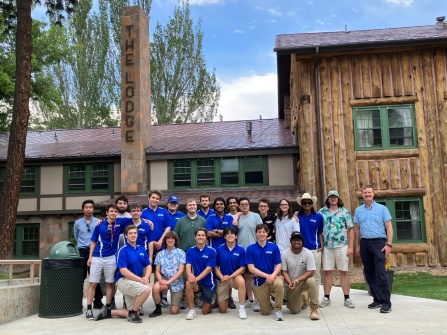
UB rocketry team at the Fuller Lodge after a successful launch!
Among the group were three senior physics students, Krish Patel, Dario Tringali, and Zaw Oo Ko, who played crucial roles in achieving lift-off. Patel is the team’s project director and leads flight simulation and recovery system sections, while Tringali (who also served as president) and Zaw lead the avionics section, which is in charge of designing custom electronics that track data and provide telemetry for the rocket.
All three students joined the club early in their academic careers. Tringali says, “I’ve always been interested in space exploration and wanted to join a project that would achieve tangible results.” It was a critical time for the club as it tried to recover from the COVID-19 pandemic. As Tringali puts it, “… the pandemic had killed the club. Our sections had no returning members, so we kind of had to start from scratch.” Patel, Tringali and Zaw proved to be critical filling this gap, and have attended IREC both in 2022 and now in 2023. From their efforts, the club has experienced remarkable growth, increasing to over 100 members from just about a dozen when Tringali first joined.
This year, the team successfully competed in the challenging 10,000 ft apogee, Student Researched and Developed (SRAD) category of the competition, which requires flying on a custom motor. The rocket, VROOM, had a nominal flight to about 9000 ft, and a successful recovery with zero damage. The technical success in the flight is bolstered by “the huge priority the club has on doing everything ourselves,” according to Patel. He says, “our rocket is more student-developed than almost every other team; we mix our own propellent, do custom layups, machine almost all the parts, design and solder our own electronics and even sew our own parachutes.” The priority on student-driven design and manufacturing is what makes SEDS one of the most popular and active clubs on campus according to Zaw. He says “the club provides opportunity to do practical, real-world engineering with actual industry standard tools—that’s something you can’t find in class—I think that’s why we’re so popular.”
After a successful launch, the trip down to the sparse New Mexico desert also allowed the team to engage in some astronomy opportunities, such as stargazing. In addition, via the efforts of the club’s advisor, Professor Paul DesJardin, the group was able to visit Los Alamos National Lab and tour the High-Performance Computing Lab as well as Fuller Lodge.
Next year, though, Zaw says, “We’re not just trying to compete, we’re trying to win.”
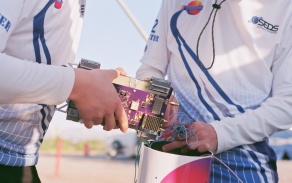
The flight electronics are undergoing final integration.
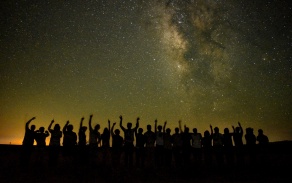
The team in the New Mexico desert stargazing. Unedited!
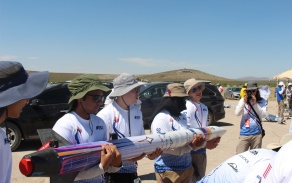
VROOM fully assembled, heading over to the launch pad. Krish (leftmost) and Dario (rightmost) holding the rocket.
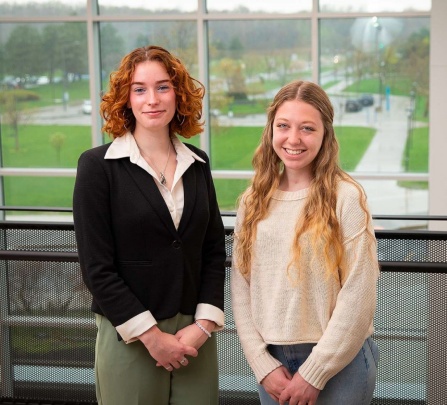
Lea Kyle (left) and Sydney Swedick are the latest UB students to receive the prestigious Goldwater Scholarship.
UB Physics Minor receives prestigious Scholarship
By Ia Iashvili, PhD
Lea Kyle, a biochemistry student, is a physics minor in our department. Her journey with us started in 2020 when she inquired about the level of difficulty at which the Honors Physics I course is taught at UB. She wondered if this would be the better option for her to learn physics, and although she hesitated with her decision, she joined the honors course and quickly rose to the top of the class. From that moment, she stayed with us and decided to sign up for a minor in physics. This year, she became one of the two UB recipients of the Barry Goldwater Scholarship 2023, the most prestigious and competitive research scholarship offered for undergraduate STEM students. Lea worked on some of her collaborative projects together with physics majors, and her Goldwater application was supported by both the UB Chemistry and Physics departments. Her plan is to do her Master's in Public Health in Ireland before pursuing a PhD in biochemistry at a top-tier university, focusing on infectious disease prevention and transmission. She wants to eventually work in the public health care sector in a national lab.
UB Physics major receives prestigious Fellowship
By John Cerne, PhD
Paul Dewan is an exceptional student. He graduated with a perfect 4.0 GPA and has been an excellent researcher in Dr. Banerjee's biophysics lab. According to Dr. Banerjee, Paul was "one of the very best I have ever mentored." His work at UB has earned him the prestigious Goldwater Scholarship in 2022 the Sekula Scholarship in 2020, and in 2020, he was inducted into the Sigma Pi Sigma Physics Honor Society. In 2023, Paul won the National Science Foundation’s prestigious Graduate Research Fellowship and was named the Physics Department’s Outstanding Senior.
In addition to his academic and research excellence, Paul has actively served the Department of Physics as a College of Arts and Sciences Ambassador from 2021 to 2023. In his senior year, Paul served as the vice president of UB's Society of Physics Students chapter. Paul is currently pursuing his PhD in biophysics at Harvard University.

Paul Dewan with his family at the “2023 Celebration of Student Academic Excellence Student Showcase” at UB in April 2023. Photo: John Cerne
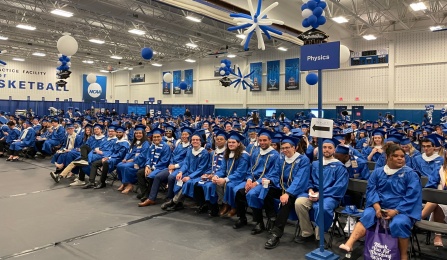
Some of our graduating seniors at the commencement ceremony.
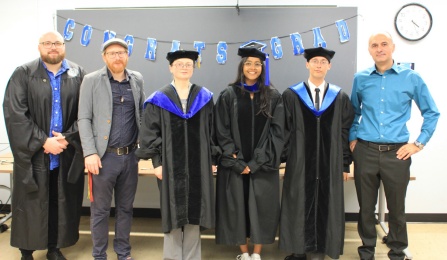
Some of our graduating Master and PhD students after the commencement ceremony. From left to right: Jeff Carvalho, MS, Dr. Tim Thomay, Dr. Ia Iashvili, Garvita Agarwal, PhD, Rance Solomon, PhD and Dr. Dejan Stojkovic.
Graduate Student Awards
Physics Graduate Student Memorial Fellowship
- Nawanath Budhathoki
- Arif Ullah
- Shang- Jie Liou
- Chiran Wijesundara
John Ho & Martha Leung Scholarship
- Mohamed Fawzy Aly
- Chang Huai
- Guangpeng Xu
- Peter Young
- Kunal Mozumdar
- David Jiayu Cao
- Nicholas Jerla
Om and Saraswati Bahethi Scholarship (2022-2023)
PhD
- Greis Cruz Reyes
- Samuel Powers
- Lauren Hay
MS
- Shreekanth Yuvarajan
- Vedant Subhash
Outstanding Teaching Assistants (2022-2023)
- Courtney Fitzgerald
- Hsin-Wei Hsia
College of arts and sciences Dissertation Fellowship
- Jiayu Cao
Silvestro Scholarship (2022)
- Samuel Powers
- Mohamed Fawzi
- Chiran Yasas Wijesundara Wijesundara Mudiyans
- Kunal Mozumdar
- Chang Huai
- Hirak Bandyopadhyay
Undergraduate Awards
Om and Saraswati Bahethi Foundation Scholarship
- Luke Di Fato
- Xuanpu Zhang
- Kevin Euscher
- Trevor Higgins
Outstanding Seniors (Physics Honors Senior Thesis)
- Keo Phaphanthong
- Joseph Ferrantini
- Xuanpu Zhang
Sekula Scholarship (2022)
- Trevor Higgins
- Shiyuan (Sean) Ge
- Thomas McEntire
- Margaret (Mars) Andersen
Sekula Scholarship (2023)
- Dario Tringali
- Thomas McEntire
- Anne Campbell
- Anthony Gullo
- Corey J. Young
- Margaret (Mars) Andersen
- Nalin Cooper-Sherrow
- Olivier Mitton
Sigma Pi Sigma Inductees (2022)
- Luke DiFato,
- Joseph Ferrantini
- Zaw Oo Ko
Recent Graduates
Physics PhD
Kevin Van Slyke (Fall 22)
Advisor: Surajit Sen
Thesis Title: “Impure gas dynamics in a nanoscale filter at intermediate Knudsen numbers”
Rance Solomon (Fall 22)
Advisor: Dejan Stojkovic
Thesis Title: "A Dissertation in the Late Universe, Recombination, and the Swampland Conjectures”
Garvita Agarwal (Summer 23)
Advisor: Ia Iashvili
Thesis Title: "Search for ttbar resonances in a di-leptonic channel with the CMS detector.”
Xing Liu (Summer 23)
Advisor: Wenjun Zheng
Thesis Title: “Investigating the gating mechanism of NMDAR by molecular dynamics simulation and machine learning”
Samuel Powers (Summer 23)
Advisor: Dejan Stojkovic
Thesis Title: “A New quantum ontology: a statistical theory of event networks built from classical bits”
PHYSICS Master's
- Cameron Ballacchino (Fall 22)
- Yue Xing (Fall 22)
- Xingyu Zhang (Fall 22)
- Jeffrey Carvalho (Spring 23)
- Vince Iglesias-Cardinale (Spring 23)
- Peter Young (Spring 23)
PHYSICS Bachelor's
- James Matthews (BA, Fall 22)
- Jeremiah Miller (Physics Minor, Fall 22)
- Karina Del Rocio Orellana (BA, Fall 22)
- Ryan Ruggiero (BA, Fall 22)
- Matthew Christiano (Physics/PhysicEd Comb BA, Spring 23)
- Eric Cicero (Physics Minor with Highest Distinction, Spring 23)
- Jonathan Daniel-Hans Gladding (Physics Minor with High Distinction, Spring 23)
- Kadin Deisenroth (Physics BS with Highest Distinction, Magna Cum Laude, Spring 23)
- Paul Dewan Jr (Physics BA with Highest Distinction, Summa Cum Laude, Phi Beta Kappa, Spring 23)
- Kevin Euscher (Physics BS with High Distinction, Magna Cum Laude, Spring 23)
- Joseph Ferrantini (Physics BS with Highest Honors and Distinction, Summa Cum Laude, Spring 23)
- Shahed Hanif (Physics BS with High Distinction, Magna Cum Laude, Spring 23)
- Trevor Higgins (Physics BS with Highest Distinction, Summa Cum Laude, Spring 23)
- Jacob Hourigan (BS, Cum Laude, Spring 23)
- Brodie Lembo (Physics BS with High Distinction, Magna Cum Laude, Spring 23)
- Gregory Mangot (BS, Spring 23)
- Alexander Mcnulty-Romaguera (Physics BS with High Distinction, Magna Cum Laude, Spring 23)
- Kacey Pearce (BS, Spring 23)
- Keopasith Phaphanthong (BS, Spring 23)
- Jay Sta. Cruz (BA, Spring 23)
- Kevin Smith (Physics BS with Highest Distinction, Summa Cum Laude, Spring 23)
- Xuanpu Zhang (Computational Physics BS with Highest Honors and Distinction, Magna Cum Laude, Spring 23)
- Luke Di Fato (Mathematical Physics BS with High Distinction, Summa Cum Laude, Summer 23)
- Shiyuan Ge (Physics BS with High Distinction, Magna Cum Laude, Summer 23)
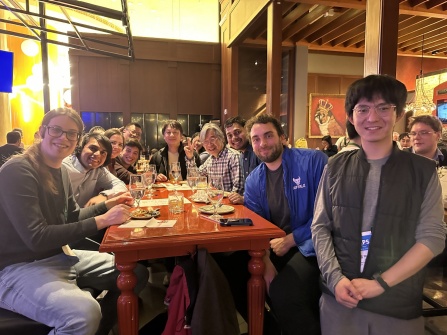
Alumni gathering at the 2023 March Meeting
By Xuedong Hu, PhD
After three years of canceled or online meetings, the APS March meeting finally returned with a fully in-person version from March 5 to 10, 2023, in Las Vegas, Nevada. A large UB Physics contingent attended the meeting and gave dozens of presentations. We also had the first UB Physics Reunion since the pandemic on March 7 in Gordon Ramsay Pub & Grill. About 30 current faculty members and students and several alumni and friends attended, including Professors Sergio Ulloa (former student of Y.C. Lee) and Nancy Sandler from Ohio University, Dr. Satoshi Okamoto from Oak Ridge National Lab, and Professor Myoung-Hwan Kim (former student of John Cerne) from Texas Tech. The event was supported by the Department of Physics and the University Advancement Office of the College of Arts and Sciences.
Thank you for your support of the Department of Physics. With the support of alumni and friends, we can provide vital resources to enhance our department and provide support for students, research projects and programs. We are grateful for your generosity.
You can support your department and help to provide for our students by making a gift online.
